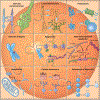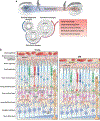Aging of the Retina: Molecular and Metabolic Turbulences and Potential Interventions
- PMID: 34061570
- PMCID: PMC11375453
- DOI: 10.1146/annurev-vision-100419-114940
Aging of the Retina: Molecular and Metabolic Turbulences and Potential Interventions
Abstract
Multifaceted and divergent manifestations across tissues and cell types have curtailed advances in deciphering the cellular events that accompany advanced age and contribute to morbidities and mortalities. Increase in human lifespan during the past century has heightened awareness of the need to prevent age-associated frailty of neuronal and sensory systems to allow a healthy and productive life. In this review, we discuss molecular and physiological attributes of aging of the retina, with a goal of understanding age-related impairment of visual function. We highlight the epigenome-metabolism nexus and proteostasis as key contributors to retinal aging and discuss lifestyle changes as potential modulators of retinal function. Finally, we deliberate promising intervention strategies for promoting healthy aging of the retina for improved vision.
Keywords: age-related macular degeneration; diet; environment; epigenome; metabolism; mitochondria; vision health.
Figures





Similar articles
-
The aging of the retina.Exp Gerontol. 2003 Aug;38(8):825-31. doi: 10.1016/s0531-5565(03)00093-7. Exp Gerontol. 2003. PMID: 12915204 Review.
-
Cellular senescence in the aging retina and developments of senotherapies for age-related macular degeneration.J Neuroinflammation. 2021 Jan 22;18(1):32. doi: 10.1186/s12974-021-02088-0. J Neuroinflammation. 2021. PMID: 33482879 Free PMC article. Review.
-
Implications of NAD+ Metabolism in the Aging Retina and Retinal Degeneration.Oxid Med Cell Longev. 2020 May 9;2020:2692794. doi: 10.1155/2020/2692794. eCollection 2020. Oxid Med Cell Longev. 2020. PMID: 32454935 Free PMC article. Review.
-
Aging and Vision.Adv Exp Med Biol. 2016;854:393-9. doi: 10.1007/978-3-319-17121-0_52. Adv Exp Med Biol. 2016. PMID: 26427437
-
Stratification of the Extent of Visual Impairment Identifies Sex-Specific Degenerative Changes in Retinal Structure and Function during Aging.J Integr Neurosci. 2025 Mar 4;24(3):25805. doi: 10.31083/JIN25805. J Integr Neurosci. 2025. PMID: 40152567 Free PMC article.
Cited by
-
An Altered Neurovascular System in Aging-Related Eye Diseases.Int J Mol Sci. 2022 Nov 15;23(22):14104. doi: 10.3390/ijms232214104. Int J Mol Sci. 2022. PMID: 36430581 Free PMC article. Review.
-
Effects of voluntary and forced physical exercise on the retinal health of aging Wistar rats.Geroscience. 2024 Oct;46(5):4707-4728. doi: 10.1007/s11357-024-01208-x. Epub 2024 May 25. Geroscience. 2024. PMID: 38795184 Free PMC article.
-
QTL mapping of human retina DNA methylation identifies 87 gene-epigenome interactions in age-related macular degeneration.Nat Commun. 2024 Mar 4;15(1):1972. doi: 10.1038/s41467-024-46063-8. Nat Commun. 2024. PMID: 38438351 Free PMC article.
-
Aging and Light Stress Result in Overlapping and Unique Gene Expression Changes in Photoreceptors.Genes (Basel). 2022 Jan 29;13(2):264. doi: 10.3390/genes13020264. Genes (Basel). 2022. PMID: 35205309 Free PMC article.
-
Transcriptional Heterogeneity and Differential Response of Rod Photoreceptor Pathway Uncovered by Single-Cell RNA Sequencing of the Aging Mouse Retina.Aging Cell. 2025 May;24(5):e70001. doi: 10.1111/acel.70001. Epub 2025 Feb 15. Aging Cell. 2025. PMID: 39954235 Free PMC article.
References
-
- Aggarwal P, Nag TC, Wadhwa S. 2007. Age-related decrease in rod bipolar cell density of the human retina: an immunohistochemical study. J. Biosci. 32:293–98 - PubMed
Publication types
MeSH terms
Grants and funding
LinkOut - more resources
Full Text Sources
Medical
Miscellaneous

